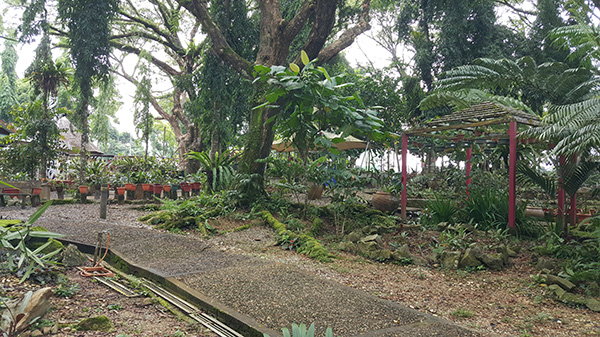
The wild orchid section of the park.
INTRIGUING are the pitchers – also known monkey cups — for they come in various shapes, sizes and colours.
Some are already quite mature — always jug-shaped. Some are elongated with a narrow neck-like amphoras while others are short or squat like mini tubs or cylindrical.
There are also different colours — from green to pink to the occasional red splotched pitchers.
Arguably, the most glorious and spectacular genus of carnivorous plants, these are the Nepenthes that fit so many of our stereotypical visions of what a carnivorous plant should be.
If you don’t believe me, come to the Pitcher Garden at Kota Padawan which showcases 55 species and sub-species of Nepenthes from steamy jungles in Sarawak.
These plants normally form enormous vines that clamber up to the trees or posts, and their carnivorous traps, as you can see at the garden, are great hungry-looking maws that look seemingly carnivorous.
And if you happen to drop by at the garden, you don’t need to understand the technical details of this plant to know it’s dangerous to animals.
In the jungle, most pitcher plants grow as lianas, and some can climb more than 10 metres up the trees. The tendrils of their leaves help them hold on to trees and bushes as support.
Some grow epiphytic while others usually stay as rosettes on the ground.
However, in the park at Kota Padawan, managed by Padawan Muncipal Council, the plants grow to the poles either in well-drained pots or on the ground.
During a recent visit to the garden, I was given to understand that pitcher plants usually produce two morphological, and sometimes, even ecological different types of pitchers.
Winged pitcher wall
This could be seen especially in the old plants that have lower or ground pitchers with their mouths looking towards the tendrils, and they have ‘wings’ on the pitcher wall.
I was told by the park officer, Stephen Lim, that when the plants begin to climb, they start producing upper or aerial pitchers.
Often, these two pitcher types look completely different, yet they may be hard to recognise since they come from the same plant.
This is true — as I was shown the upper and the aerial pitcher of the N bicalcarata which is obviously different in shape. However, we can tell they are from the same N bicalcarata species by the existence of the two thorns below the lid of the pitcher.
Lower pitchers are attached to the leaf with the site opposite to the lid and generally present in the lower part of the plant.
They are usually larger, especially basally, than the upper pitchers. It is believed that lower pitchers can even become very large when resting on the soil.
Upper pitchers are more slender and attached to the leaf with the side that carries the lid. These are always in the upper part of the plant.
The leaf morphology of Nepenthes is also among the strangest found in the kingdom of plants.
The pitcher is actually the lamina or leaf spade while the tendril is the stalk. What looks like the leaf is an extremely enlarged leaf base —the part of the stalk next to the stem.
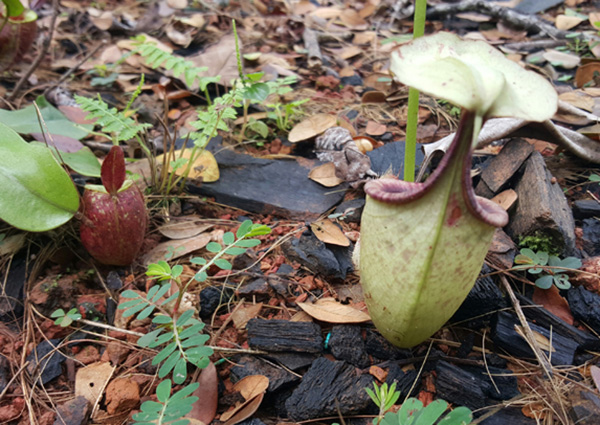
The N ampullaria pitcher (left) with the bigger N X hookeriana hybrid.
Interesting feature
Another interesting feature, if you are observant enough, is that no two pitchers are exactly the same although they are from the same plant — with each seemingly having different mottled colours on its first coat of outer surface.
The pitchers are believed to have evolved to trap, and in many cases, secrete enzymes to digest trapped animals for their nutritional requirements.
Those species which do not have digestive enzymes, may rely on bacteria or other organisms for the digestion processes.
Lim said because the enzymes were critically essential to the longevity of the pitcher, visitors to the park were not allowed to pour out the water of the pitcher or the cup.
“If you empty the enzymes or the water from inside the pitcher, it will get dry and die very soon … even in one day even.
“But if the enzymes remain there, it can last for two to three weeks,” he explained.
He noted that a fine of RM500 would be imposed on any visitor who damaged, stole or did any harm to the plant.
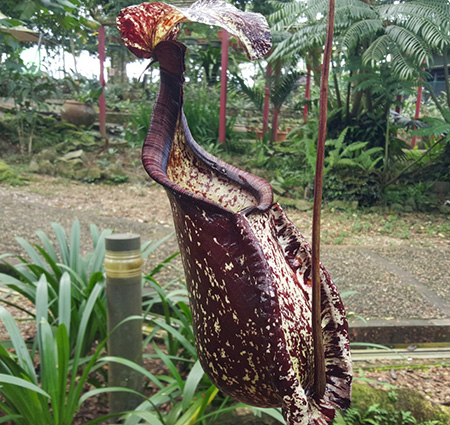
A giant form of N rafflesiana.
Slippery wall trap
It is believed that pitcher plants rely on the slippery walls and the pools of fluid in their pitchers to trap their prey.
The nectar gland beneath the lid of the pitcher is believed to attract insects to crawl up or land there, thereby setting the trap, while the fluids in the pitchers have been found to be at least slightly acidic.
The species and sub-species of Nepenthes available at the MPP Pitcher Garden range from the largest N rafflesiana, which has the ability to store a litre of fluid, to the tiniest N gracilis.
Lim said there were nine or 10 sub-species of N rafflesiana collected from the jungles of Sarawak.
N rafflesiana usually produces two distinct types of pitchers (heavily modified leaves) which are used to capture and kill insect prey for nutrients.
The lower pitchers are generally round, squat and ‘winged’ while the upper pitchers are much narrower at their base.
The species is widely variable and comes in a variety of shapes and colors. Most contain varying amounts of green, white, and maroon streaks.
Nepenthes rafflesiana is said to kill by luring its prey into its pitchers whose peristomes secrete sweet-tasting nectar.
Once inside, the insect quickly finds the walls of the pitcher too slippery to scale, and drowns.
Digestive enzymes released by the plant into the liquid, break down the prey and release soluble nutrients, which are absorbed by the plant through the walls of the pitcher.
The giant form of N Rafflesiana is a much larger plant than the typical form in all respects.
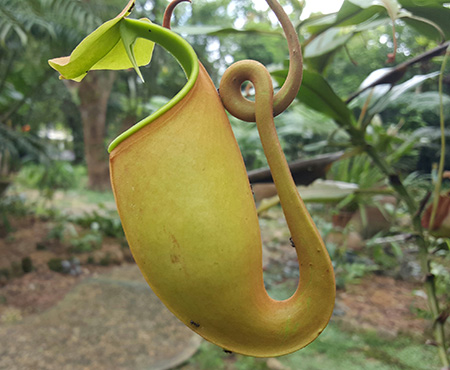
The upper pitcher of
N bicalcarana.
Longest pitchers
Lim said the longest pitchers of the giant plants of N Rafflesiana recorded in Sarawak measured one foot three inches while the longest in the world was about two feet.
He also showed me the biggest pitchers of N rafflesiana, collected in one of the jungles in Kuching recently. The typical habitat of this form is dense heath forest , especially around vegetation boundaries.
Its pitchers vary widely in pigmentation — from white with red blotches to dark purple. Upper pitchers may be spotted or green throughout. The inflorescence is also massive, reaching over 1m in length.
In addition to its size, the giant form is distinguished by the colour of its developing leaves which have a bronze sheen.
The tiniest N Gracilis is a widespread, common and weedy species.
It is told apart by the triangular stems, the decurrent leaf bases which run down the stem ridges, and the absence of a white band of hairs below the peristome.
The small, elongated pitchers of Nepenthes gracilis appear relatively unremarkable and have a very thin peristome .
Nevertheless, the species is unusual and possibly unique in that the underside of the pitcher lid bears an uneven layer of wax crystals.
Another interesting species to see at the park is the Nepenthes bicalcarata.
The two thorns that give N bicalcarata its name are unique to this species and bear some of the largest nectaries in the plant kingdoms.
Common in peat forest
Endemic to Borneo, it’s most common in the peat swamp forests and kerangas forest.
N bicalcarata is said to play host to an unusual species of ants which make its nest in the plant’s hollow tendrils.
Described as Camponotus schmitzi in 1933, they are a member of the extremely populous and widespread genus of carpenter ants.
Then there is N ampullaria whose stem is light brown in colour and pitchers are produced at the ends of short tendrils no more than 15cm long.
The pitchers are generally quite small, rarely exceeding 10cm in height and 7cm in width.
Pitchers range in colouration — from light green throughout to completely dark red with many intermediate forms recorded.
Also do not miss seeing the N reinwardtiana species. This has an unusually wide altitudinal distribution, being both a ‘lowland’ and ‘highland’ plant.
There are many different colour forms — ranging from green to dark red. This species is known for the two “eye spots” on the inside surface of its pitchers.
There are also several hybrids species at the park. Among them are N X Hookeriana and N bicalcarata X N gracilis.
They are hybrids by nature, where two species of Nepenthes growing close together to produce a cross species.
For example, N X hookeriana is a cross between N ampullaria and N rafflesiana. This species has a body structure of N ampullaria with lid and peristome of N rafflesiana.
Lim said pitcher plants were not costly to maintain, being self-feeding carnivorous plants.
“They do not need fertiliser. We just to make sure they have enough water while enough sunlight is only needed for certain species,” he added.
In line with conservation efforts, visitors are notified pitcher plants are protected species in Sarawak.
Other than pitcher plants, there are also small collections of wild orchids and rare exotic wild plants.
The park was reopened in January this year and an entrance fee of RM6 is charged per tourist and RM3 for Malaysians.
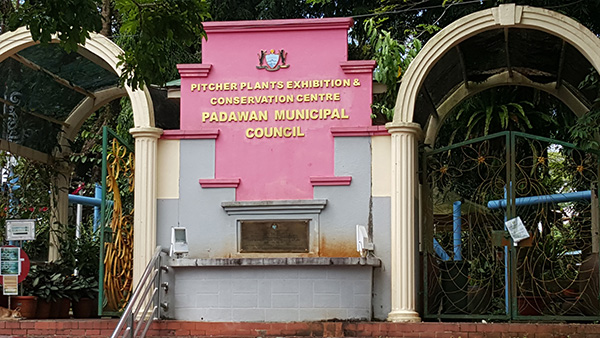
The entrance to the MPP Pitcher Garden at Mile 10 or Kota Padawan.
